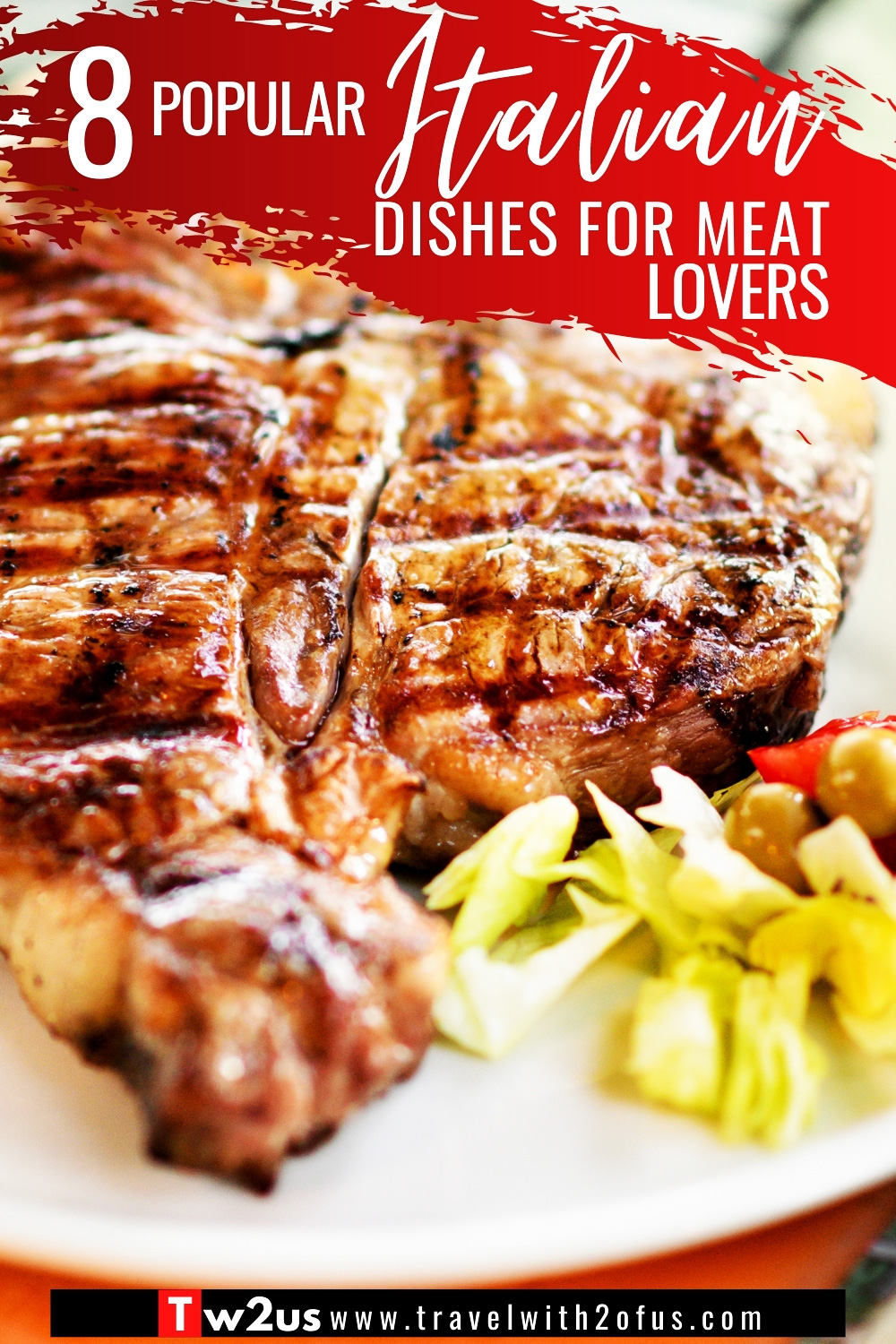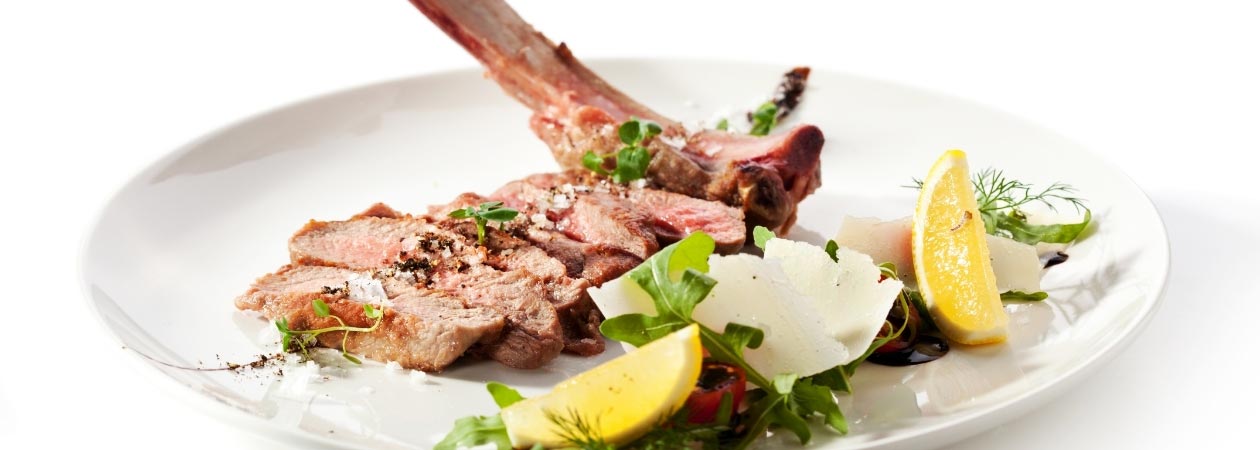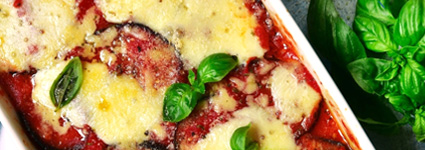8 Popular Italian Dishes For Meat Lovers
March 24th, 2021, Posted by travelwith2ofus

🔽 DEAL ALERT!
Get up to 20% off selected hotels!
![]()
![]()
Do you love Italian food? Do you know that each of the 20 Italian regions has its own gastronomic traditions.
These regions tend to fit into one of three groupings. These regional groupings are Northern, Central, and Southern Italy. Here are a few examples of Italian regional dishes.
Tuscany: Tuscany is home to some of Italy's best meat dishes, including steak alla Fiorentina.
Lazio: Lazio has a reputation for Porchetta.
Lombardy: Is know for risotto alla Milanese and Osso Buco.
Italy is famous for its cured meats such as prosciutto, pancetta, coppa, and bresaola, and Italians are so very inventive when it comes to preparation methods.
In recent years, Italian chefs have pushed well beyond the boundaries of their creativity.
There is a large variety of Italian meat recipes, so it is just a matter of which one will tempt you. Have a look at these eight Italian meat dishes that will remind you why you love meat so much.
There are also many Italian vegetarian dishes worth trying.
Arista alla Fiorentina (Tuscan Roast Pork)
Arista is a traditional roast pork dish from Tuscany. It is made using seared pork loins seasoned with rosemary, garlic, salt, sage, and black pepper. The meat is then placed in a baking tin with olive oil and frequently turned while it slowly cooks.
The dish was named Arista around 1430 when Byzantine Patriarch Bessarion tasted it and immediately exclaimed: "Aristos," which means "Best or Excellent." An alternative theory was that the dish was named after the Latin word for the upper part (Arista).
Try this recipe
Ingredients
4 large garlic cloves, peeled
2 tablespoons fresh rosemary leaves
2 tablespoons chopped fresh sage leaves
1 oil-packed anchovy fillet or 1 teaspoon anchovy paste (optional)
5 tablespoons extra-virgin olive oil
2 pounds boneless center-cut pork loin (not tenderloin), with as much fat on top as possible
2 bay leaves (optional)
About 3/4 teaspoon kosher salt
Preheat the oven to 225°F (110°C) and position a rack in the center of the oven.
Meanwhile, in the bowl of a small food processor, combine the garlic, rosemary, sage, anchovy (if using), and 3 tablespoons oil and process until a coarse paste forms. (Alternatively, you can use a mortar and pestle.)
If desired, use kitchen string to tie the pork tightly crosswise about every 2 inches (5 cm). You can slip the bay leaves under the twine if you like.
Season the pork on all sides with the salt, rubbing the meat to coat it.
In a large ovenproof skillet over medium-high heat, heat the remaining 2 tablespoons oil until shimmering. Add the pork and sear, starting with the fatty side and using tongs to turn it, until dark golden brown on all sides, 8 to 10 minutes total. Turn off the heat and let the pork in the skillet.
Using an offset spatula or pastry brush, coat the pork with the herb mixture. If you’re the sort who likes the punch of raw garlic, reserve 1 tablespoon of the herb mixture to coat the pork after it comes out of the oven.
Transfer the skillet to the center rack in the oven and roast until the meat is tender and the internal temperature is around 180°F (82°C), 2 to 2 1/2 hours. (Rest assured, if you just got alarmed at those numbers, that although this is a much higher internal temperature than we typically cook pork, it works.)
Remove the skillet from the oven. If desired, brush the top and sides of the pork with the reserved 1 tablespoon herb mixture. Let the pork cool for at least 5 minutes.
Transfer the pork to a cutting board, reserving the cooking juices in the skillet. Remove and discard the string and bay leaves, if using.
Slice the pork very thinly (about 1/8 inch | 4 mm thickness) and arrange the slices on a serving platter. Drizzle with the juices and herbs from the pan. Serve warm or at room temperature.
Check out the full recipe and instructions at Leite's Culinaria.
Check out this video of a version of
Arista alla Fiorentina (Tuscan Roast Pork).
Braciola (Braciole)
Braciola is known as a main course dish. However, it is not unknown for smaller portions to be served as a side dish.
To produce Braciola, take a piece of thinly sliced pork, beef, veal, or chicken, hammer it until it is a thin sheet, then fill it with ingredients such as fresh herbs, cheese, prosciutto, and nuts.
It is tied, then seared and simmered in tomato sauce until it is tender. The meal is best served while still hot.
The origin of Braciola is Sicily, but it has been taken to the US and Australia by immigrants.
Watch Gina make Braciola.
Check out our graphic Apparel And Home Decor
Our "food" designs are available on clothing and home decor products including, t-shirts, hoodies, tank tops, sweatshirts, sleeveless tops, laptop skin, laptop sleeve, iPad skins, coffee mugs, kitchen aprons, and much more.
Saltimbocca alla Romana
Saltimbocca alla Romana is a favorite dish of the Lazio region. It is said to have been invented in the city of Brescia. It only became part of Roman cuisine in the 1800s.
The authentic recipe always uses veal, prosciutto, sage, and Italian white wine, while butter is used to prepare the sauce.
Saltimbocca alla Romana has become a regular dish in Italian restaurants, and many people consider it to be one of the most delicious Italian dishes.
The name translates to "Jump in the mouth," which is quite apt as it will surely excite your taste buds.
Check out this video on how to make
Saltimbocca alla Romana with Valerio's.
Bistecca alla Fiorentina (Florentine Steak)
Bistecca alla Fiorentina is an Italian Steak dish that features veal or heifer seasoned with rosemary and salt and grilled. It is prepared in a specific way and is one of the most popular dishes from Tuscany.
The origins of Florentine Steak can be traced from the feast of St Lawrence and to the house of Medici.
Bistecca, it is said, was derived from the English term "Beef Steak," which is what a group of English knights called it when offered the food in Florence.
Traditional accompaniments to Bistecca alla Fiorentina are cannellini beans dressed with olive oil or a salad. Porterhouse steak is the prefered cut of meat.
Porchetta
Porchetta is a roast of a pig that has been deboned and stuffed, typically with wild fennel and liver.
All the fat is left on, as is the skin. Porchetta is heavily salted and cooked over wood on a spit or oven for several hours (at least eight hours).
The dish was made famous in the Lazio region but can now be found all over Italy. Porchetta is one of the two specialties of the Lazio region. The other is Pecorino Romano (a sheep cheese).
Check out this video on how to make
Porchetta with Vito Bernabei.
Check out Our Latest Youtube video
8 Tasty Italian Vegetarian Dishes You Will Love.
We have links to product and services from our affiliates. We may receive compensation when you click on those links, at no cost to you of course.
3 kitchen must-haves
Whether you're looking to make home-made pasta or grill some burgers indoors, these kitchen must-haves will make your job a lot more enjoyable. They make great gifts are well.
Ossobuco alla Milanese
Ossobuco alla Milanese is a regional specialty of Italy's Lombard region. The dish consists of cross-cut veal shanks braised in vegetables, white wine, and broth.
It is often garnished with gremolata and served with Risotto alla Milanese. In some regional versions, the bone marrow is particularly prized.
More modern versions of this dish use tomatoes, whereas the traditional versions do not. Bay leaf, cinnamon, and gremolata in the traditional versions are sometimes replaced with tomatoes, celery, carrots, and onions.
The regional cuisine of Lombardy is very dependent on rice, beef, pork, lard, and butter. It has little in common with southern Italian cuisine.
Watch Chef Alessandro Negrini cook Ossobuco alla Milanese!
StEak Alla Pizzaiola
If you have ever been to an Italian restaurant and ordered Steak Pizzaiola, you will have learned that Pizzaiola does not look anything like pizza. Pizzaiola or Carne Pizzaiola, roughly translated mean "Meat in Pizza style."
The dish has its origin from Napoli and referred to less expensive cuts of meat cooked together with tomatoes, garlic, olive oil, and white wine. Typically the dish will include tomato paste, oregano, and basil.
Watch lovable Gina Petitti "the Italian Grandma" make Stake Alla Pizzaiola.
Carpaccio
Carpaccio is a dish of thinly sliced meat or fish served raw. The meat might be beef, venison, veal, tuna, or salmon. The dish is typically served as an appetizer.
Carpaccio was invented by Giuseppe Cipriani (who founded the famous Harry's Bar in Venice. It became popular in the second half of the 20th century.
The Carpaccio in Harry's bar is served with lemon, olive oil, and white truffle. Later they widened the definition of Carpaccio to include other meats as well.
Watch Steve Maresch make Beef Carpaccio.
Which is your favorite Italian Vegetarian Dish?

You may also like:
FASHION









 8 Tasty Italian Vegetarian Dishes You Will Love
8 Tasty Italian Vegetarian Dishes You Will Love How To Make 4 Of Sandals Resorts Signature Cocktails
How To Make 4 Of Sandals Resorts Signature Cocktails Recipes Of Caribbean Cocktails That Are So Easy To Make
Recipes Of Caribbean Cocktails That Are So Easy To Make Comfortable Spring fashion for travel
Comfortable Spring fashion for travel Casual And Comfortable Sandals For Travel
Casual And Comfortable Sandals For Travel